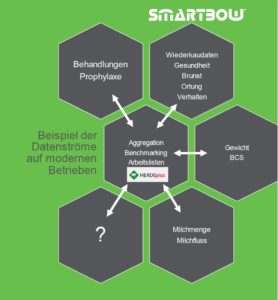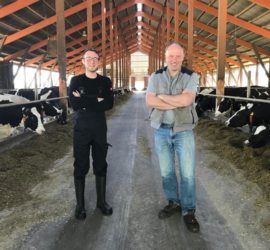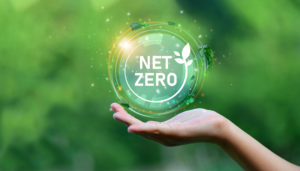
Just a few seats left: NDL digital leader roadtrip 2024
News about our NDL roadtrip 2024, program and tickets
Start » Blog » Digital Farming & Agribusiness » Perfectly connected – the farm of the future
– a blog post by NDL member Smartbow by Zoetis –
Simple and automated data networking and easy operability of agricultural software and portals are what most farms want in order to make themselves fit for the future. But what is holding back networking and interface building?
In the meantime, farms have integrated countless systems into their everyday work: Milking parlors, milking robots, health systems, heat detection systems, feeding technology, herd management systems and many more provide data on the herd and individual animals every day. Large amounts of data are thus generated every day. On the other hand, it means that many different evaluations are created in different presentations – this can quickly become confusing, complicated and time-consuming. Time that a herd manager would rather invest sensibly in his or her herds. What would be a possible solution to facilitate the handling of the data volumes? To be able to use all the data of the farm in a compressed and simple way – that is the dream of every herd manager.
The evolution of dairy farms in recent decades has been accompanied by incredible changes: from handwritten notes to digital ear tags on the cow and push messages sent automatically to the smartphone. Little by little, more and more farm support technologies and applications have come to agriculture, all with the same goal: to make the life of farmer and animal easier and better at the same time.
Basically a great idea, if it weren’t for the vast amounts of data from programs that don’t communicate with each other. Each individual system outputs its values differently. There is no question of clarity here. For farms, this can quickly turn out to be an enormous additional expense. Different systems, different applications, lots of data and time-consuming multiple entries.
In a Bitkom survey from 2016, 60% of the farmers surveyed (n=521) stated that their interest in data use was high if it meant less bureaucracy for them. So far, this is only partially the case or not at all.
On the customer side, there is the fear of data sharing or the lack of knowledge of what is being done with the data. Accordingly, data sovereignty must be defined by each data-processing company. For Zoetis, reliable data protection is a prerequisite for all products and services. In addition, Zoetis Deutschland GmbH is a member of Animal health Europe and thus committed to the “EU Code of conduct on agricultural data sharing by contractual agreement“.
The following obstacles were named in response to the question “What is currently preventing the complete exchange of data?”: Lack of awareness of the interfaces, incompatibility of the interfaces, high technical effort and the willingness of the manufacturers. So even if you are ready to build interfaces, there are adversities that slow down or even inhibit the development of data networking. We should tackle this together in the future!
A platform is needed where all the data of the farm can be gathered, communicate with each other and create collected content in logical and usable information. As a perfect support for farmers and herd managers to make informed decisions and work more efficiently.
Digitization and data must be easily accessible and understandable. They should make everyday life easier, not more difficult – which is why cross-application interfaces need to be created.
SMARTBOW from Zoetis is leading the way here and has already integrated interfaces to leading herd management systems such as DSP Agrosoft, UNIFORM-Agri and DairyComp.
The first example shows, among other things, the data flows on a modern farm in Germany, which has also implemented SMARTBOW from Zoetis on the farm. As can be seen, the HERDEplus herd management program is the pool here, where the data flows together and is utilized accordingly. A typical exchange of data could look as follows: A herd alarm is generated in the SMARTBOW system. This information is transferred to HERDEplus. The farmer checks the animal and makes the decision to inseminate. The farmer then enters the insemination into HERDEplus. Thus the insemination event automatically goes into the SMARTBOW software and can be seen in both systems.
You can learn more about this in our online seminar on the topic of interface with DSP Agrosoft: To the online seminar

A second successful example is Milchhof Reeßum KG, where farm manager Frank Cordes and herd manager Jan Intemann are already working with many digital solutions for their 750 cows.

Discuss with us in the network. Become a network partner and let’s build bridges together:
Your contact to the network: hello@digital-livestock.com
Your contact to SMARTBOW: smartbow@zoetis.com

Just a few seats left: NDL digital leader roadtrip 2024
News about our NDL roadtrip 2024, program and tickets

Save your seat: NDL Meet Up & new digital Pitches coming up in Q4|2023
NDL Meet Up Conference 29’/30′ Nov. | Online Pitches with Agolin & Arla in Oct. & Dec.

Get your NDL road trip 2023 tickets now! (only til April 20)
Dear NDL followers, friends and partners!
We are excited to announce that sign-up for the Network Digital Livestock road trip event is now open!
Copyright © 2023 NDL. All rights reserved. | Privacy Policy | Imprint | Cookies